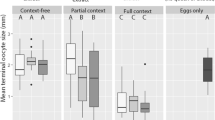Abstract
Among Vespinae both the queen and the workers build cells of a typical architectural design which are suitable for rearing a brood. In the case ofVespa orientalis, but not in the speciesV. crabro, Paravespula vulgaris,P. germanica, Dolichovespula saxonica, orD. media, groups of workers of various ages which are kept in artificial breeding boxes in the absence of a queen continue to build new cells and even entire combs. Workers which are deprived of a queen build worker cells but not queen cells. The construction commences from a central point where the workers had congregated for a while. The site of construction can be preselected by intentionally directing the workers to rest in a particular spot. Once the building has been initiated, the workers will persist building in the same spot over and over again, even after any imposed limitation has been removed. In this last respect,Polistes foederatus emulatesV. orientalis. From the above results, it would seem that hornets resting in a particular spot for a length of time deposit there a substance—probably volatile—which induces assembly of hornets in that spot. Furthermore, the hornets deposit there the same or another substance which stimulates the initiation of building. It is proposed to name this substance a building initiating pheromone. A distinction should be made between the building pheromone released by the workers and usually initiating the building and similar pheromones released by the queen which are capable of either initiating or restricting the building.
Similar content being viewed by others
References
Blum, M.S., andBrand, J.M. 1972. Social insect pheromones: Their chemistry and Function. Am. Zool. 12:553–576.
Butler, C.G., Fletcher, D.J.C., andWatler, D. 1969. Nest-entrance marking with pheromones by the honeybeeApis mellifera L. and by a wasp,Vespula vulgaris. L.Anim. Behav. 17:142–147.
Ikan, R., Gottlieb, R., Bergmann, E.D., andIshay, J. 1969. The pheromones of the queen of the Oriental hornetVespa orientalis.J. Insect Physiol. 15:1709–1712.
Ishay, J. 1964. Observations sur la biologie de la Guêpe OrientaleVespa orientalis.Insect. Soc. 11(3):193–206.
Ishay J. 1965. Entwicklung und Aktivität im Nest vonVespa orientalis.Dsch. Entomol. Zeit. 12(4/5):397–419.
Ishay, J. 1973. Thermoregulation by social wasps: Behavior and pheromones.Trans. N. Y. Acad. Sci. 35(6):447–462.
Ishay, J. 1975a. Hornet nest architecture. Nature 253:41–42.
Ishay, J. 1975b. Caste determination by social wasps: Cell size and building behavior.Anim. Behav. 23:425–431.
Ishay, J. 1975c. Orientation by pupating larvae inVespa orientalis.Insect. Soc. 22(1):67–74.
Ishay, J. 1976a. Comb building byVespa orientalis.Anim. Behav. 24(1):72–83.
Ishay, J. 1976b. Geotaxis by hornet workers and its improvement during the first days of life as an adult.Insect. Soc. 23:243–252.
Ishay, J., andRuttner, F. 1971. Die Thermoregulation im Hornissennest.Z. Vergl. Physiol. 72:423–434.
Ishay, J., andSadeh, D. 1975. Direction finding of hornets under gravitational and centrifugal forces.Science 190:802–804.
Ishay, J., andSadeh, D. 1977. Geotropism of hornet comb construction under persistent acceleration.Behav. Ecol. Sociobiol. 2:119–129.
Ishay, J., Bytinski-Salz, H., andShulov, A. 1967. Contributions to the bionomics of the Oriental hornetVespa orientalis.Isr. J. Entomol. 2:45–106.
Ishay, J., Ikan, R., andBergmann, E.D. 1965. The presence of pheromones in the Oriental hornetVespa orientalis.J. Insect Physiol. 11(9):1307–1309.
Jeanne, R.L. 1975. Behavior during swarm movement inStelopolybia areata (Hymenoptera: Vespidae).Psyche 82(2):259–264.
Kisliuk, M., andIshay, J. 1977. Influence of an additional magnetic field on hornet nest architecture.Experientia 33(7):885–887.
Kugler, J.,Motro, M., andIshay, J. 1979. Nest founding and building activities ofVespa orientalis. Insect. Soc. (in press).
Montagner, H. 1964. Instinct et mecanismes stéréotypés chez les guêpes sociales.Psychol. Fr. 9:257–259.
Motro, M. 1977. Social activities by queenless hornet workers (Vespa orientalis L.): Hierarchy, ovary development and comb building. M.Sc. thesis, Tel Aviv Univ., pp. 9–68.
Motro, M.,Motro, U.,Ishay, J.S., andKugler, J. 1979. Social and dietary prerequisites ofVespa orientalis workers.Insect. Soc. (in press).
Neuman, M.G. 1976. Swarming behavior: Evidence for communication in social wasps.Science 189:642–644.
Pardi, L. 1940. Ricerche sui Polistini. I. Poliginia vera ed apparente inPolistes gallicus (L)Proc. Verb. Soc. Tose. Sci. Natl. Pisa 49:3–9.
Pardi, L. 1942. Ricerche sui Polistini. V. La poliginia iniziale diPolistes gallicus (L.)Boll. 1st. Ent. Univ. Bologna 14:1–106.
Pardi, L. 1948. Dominance order inPolistes wasps.Physiol. Zool. 21(1):1–13.
Perna, B. 1976. Osservazioni sulla poliginia diPolistes foederatus indotta in cattivita. Tesi di Laurea, Facoltà di Scienze Matematiche Fisiche e Naturali, Università degli Studi di Firenze, pp. 1–75.
Perna B.,Marino Piccioli, M.T., andTurillazzi, S. 1979. Osservazioni sulla poliginia diPolistes foederatus (Kohl) (Hymenoptera, Vespidae) indotta in cattivita.Boll. 1st. Ent. Univ. Bologna (in press).
Roland, G. 1976. Approche eco-ethologique et biologique des Societes deParavespula vulgaris etgermanica. These de Docteur Es-Sciences Naturelles. Univ. de Nancy, pp. 1–309.
Röseler, F.F., andRöseler, I. 1977. Dominance in bumblebees, pp. 232–235.in Proc. 8th Int. Congr. I.U.S.S.A. 1977: XI + 325 pp. Wageningen, The Netherlands. Velthuis, H.H.W., and Wiebes, J.T. (eds.).
Shorey, H.H. 1976. Animal Communication by Pheromones. Academic Press, London, pp. 1–167.
Spradbery, J.P. 1973. Wasps. Sidgwick & Jackson, London, pp. 1–408.
West-Eberhard, M.J. 1969. The social biology of polistine wasps. Miscellaneous Publications, Museum of Zoology, Univ. of Michigan 140:1–101.
Wilson, E.O., andBossert, W.H. 1963. Chemical communication among animals.Rec. Prog. Horm. Res. 19:673–716.
Wilson, E.O. 1971. The Insect Societies. Harvard Univ. Press, Cambridge, Massachusetts, pp. 1–548.
Author information
Authors and Affiliations
Rights and permissions
About this article
Cite this article
Ishay, J.S., Perna, B. Building pheromones ofVespa orientalis andPolistes foederatus . J Chem Ecol 5, 259–272 (1979). https://doi.org/10.1007/BF00988240
Received:
Revised:
Issue Date:
DOI: https://doi.org/10.1007/BF00988240




